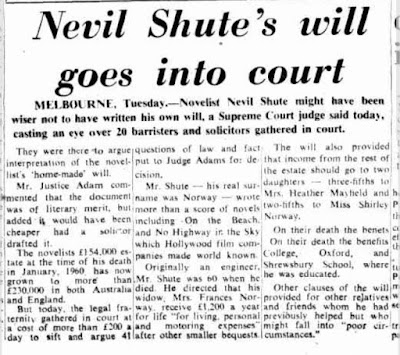Here's the proof that Nevil Shute Norway lived in Langwarrin. He is listed in the Shire of Cranbourne Rate Books 1950/1951 as having 47 acres and 30 acres. You might need to click on the images to enlarge them.
The other connection to the area was that when the book was made into a film starring Gregory Peck and Ava Gardner in 1958 and 1959 scenes were filmed at George Wilson’s property at Harkaway Road in Berwick. This filming took place in January 1959 when the temperature was 106 to 109 degrees (41 - 42 degrees Celsius). Only four of the nine Berwick scenes ended up in the final cut. Shute Avenue and Kramer Drive in Berwick are lasting memorials to the film location.
You can read about the making of the film, directed by Stanley Kramer, in this account written by Philip Davey, here https://2015.acmi.net.au/acmi-channel/2009/film-essay-on-the-beach/ Philip Davey is the author of the book When Hollywood came to Melbourne : the story of the making of Stanley Kramer's On the beach, published in 2005.
Here are some photos we have in the Archive, donated by a member of the Wilson family, of the filming of On the Beach in Berwick.
Ava Gardner and Gregory Peck
The following account of Nevil Shute's life is taken from Julian Croft's article published in the Australian Dictionary of Biography, you can read it in full, here. Nevil Shute (real name Nevil Shute Norway) was born in London on January 17, 1899 and went to Oxford University and became an engineer. He started his working life at de Havilland Aircraft Co. and also learnt to fly. He then worked at Vickers Ltd. During this time he was also writing novels which he had published under the name of Nevil Shute, so as not to compromise his professional engineering career. In 1932 he established his own company, Airspeed Ltd, which was quite successful - however he parted company with Airspeed Ltd, amicably it seems, in 1938 and received a large payout that allowed him to write full time.
Portrait of Nevil Shute by Ian Hassall, 1962.
National Library of Australia https://nla.gov.au/nla.obj-134347151/view
In 1950 Nevil, his wife Frances (nee Heaton) and their two daughters migrated to Australia, to Langwarrin. A town like Alice which was published in 1950 was written at Langwarrin, other novels followed and it was in 1957 that On the Beach was published. Nevil died on January 12, 1960 of a cerebral haemorrhage. He was cremated at the Necropolis at Springvale.
Anglican Church of St Thomas, Lanwarrin
Photo from the Parish website http://www.lpac.org.au
This report was in Canberra Times of May 20, 1961
Canberra Times August 12, 1964
* The information about the Church comes from the book Church of St Thomas, Langwarrin: a potted construction history - celebrating the centenary of Nevil Shute Norway written and published by David Caldwell in 1999. Mr Caldwell was the Architect who worked on the Church. The description of the Church being 'highly mannered etc' was from Graeme Butler & Associates from their 1997 Frankston City Heritage Study and quoted by Mr Caldwell.











No comments:
Post a Comment